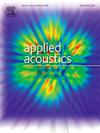Asymmetric sway panel design for noise reduction by modal radiation efficiency tunning approach
IF 3.4
2区 物理与天体物理
Q1 ACOUSTICS
引用次数: 0
Abstract
Built-up panels are widely employed for noise reduction, with their effectiveness primarily dependent on transverse vibrations, as corroborated by numerous studies. Transverse vibrations occur perpendicular to the panel’s surface and are known for their substantial sound radiation. This study introduces a novel technique for tuning modal radiation efficiency, designed to diminish sound radiation from a sway panel comprised of two vertical and one horizontal segment. Notably, when the primary vibration direction of a panel is parallel to its surface (i.e., sway vibration), both the level of transverse vibrations and the corresponding sound radiation efficiency are significantly reduced. A theoretical model was developed to investigate the interplay between transverse and longitudinal vibrations across adjacent components, shedding light on the sound radiation reduction mechanism. The sway structure exhibited a 43.5 % reduction in maximum transverse displacement compared to a simply supported beam, while the maximum longitudinal displacement was adjusted to align with the transverse displacement levels. Moreover, sway modes, in comparison to simply supported beams, demonstrate reduced radiation efficiency due to their dipole-like sound radiation patterns. Consequently, the maximum sound pressure level of the sway structure was lowered by 7 dB compared to that of the simply supported beam. This model also enables the creation of two sway modes with closely spaced frequencies through precise modifications of lengths and thicknesses, highlighting the significance of asymmetric geometry. Furthermore, comparisons of the proposed model with finite element methods and experimental results confirm a strong concordance, validating the effectiveness of the sway structure in achieving reduced sound radiation.
基于模态辐射效率调谐方法的非对称减噪面板设计
组合式面板被广泛用于降噪,其有效性主要取决于横向振动,许多研究证实了这一点。横向振动垂直于面板表面发生,并以其大量的声辐射而闻名。本研究介绍了一种新的模态辐射效率调谐技术,旨在减少由两个垂直段和一个水平段组成的摇摆板的声辐射。值得注意的是,当面板的主振动方向平行于其表面时(即摇摆振动),横向振动水平和相应的声辐射效率都明显降低。建立了一个理论模型来研究相邻部件的横向和纵向振动之间的相互作用,从而揭示声辐射减少机制。与简支梁相比,摇摆结构的最大横向位移减少了43.5%,而最大纵向位移被调整为与横向位移水平一致。此外,与简支梁相比,摇摆模式由于其偶极子样声辐射模式而显示出降低的辐射效率。因此,与简支梁相比,摆动结构的最大声压级降低了7 dB。该模型还可以通过精确修改长度和厚度来创建两种频率间隔紧密的摇摆模式,突出了不对称几何的重要性。此外,将所提出的模型与有限元方法和实验结果进行比较,证实了较强的一致性,验证了摆动结构在实现降低声辐射方面的有效性。
本文章由计算机程序翻译,如有差异,请以英文原文为准。
求助全文
约1分钟内获得全文
求助全文
来源期刊

Applied Acoustics
物理-声学
CiteScore
7.40
自引率
11.80%
发文量
618
审稿时长
7.5 months
期刊介绍:
Since its launch in 1968, Applied Acoustics has been publishing high quality research papers providing state-of-the-art coverage of research findings for engineers and scientists involved in applications of acoustics in the widest sense.
Applied Acoustics looks not only at recent developments in the understanding of acoustics but also at ways of exploiting that understanding. The Journal aims to encourage the exchange of practical experience through publication and in so doing creates a fund of technological information that can be used for solving related problems. The presentation of information in graphical or tabular form is especially encouraged. If a report of a mathematical development is a necessary part of a paper it is important to ensure that it is there only as an integral part of a practical solution to a problem and is supported by data. Applied Acoustics encourages the exchange of practical experience in the following ways: • Complete Papers • Short Technical Notes • Review Articles; and thereby provides a wealth of technological information that can be used to solve related problems.
Manuscripts that address all fields of applications of acoustics ranging from medicine and NDT to the environment and buildings are welcome.
 求助内容:
求助内容: 应助结果提醒方式:
应助结果提醒方式:


